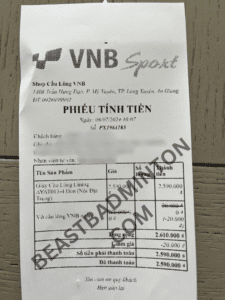
In this Li-Ning Mirage Pro review, I’ll share my experience as an intermediate player after having tested this badminton shoe for ten hours on court.
UPDATE: If you’re curious how it’s been to play with a year later, here’s an update to the Mirage Pro.
It’s so new that I didn’t notice any of the pro players at the 2024 Paris Olympics wearing it. Instead, the Li-Ning sponsored players, like Ginting from Indonesia, tend to use the older Li-Ning Blast Pro (JF-01) if they prefer this type of shoe.
Since both shoes are lined up in Li-Ning’s 2024 catalog, I imagine those players might transition to this newer model after the Olympics.
Based on how it felt to play in along with its weight, I’m categorizing it as a speedy, featherweight shoe, competing directly with Yonex’s Aerus Z2 and Victor’s new S82III for your hard-earned cash.

This low-weight badminton shoe category tends to be most popular for tournament players where performance and speed are crucial, and among players with a small body frame that doesn’t require as much padding.
I’m an average-sized Western player and for me, this shoe category tends to be too fatiguing, but readers in this weight class have pointed out how much they enjoy it.
When I threw this pair on the scale, they came in at 293g per shoe in my size 28.5cm (7% heavier than the Yonex Aerus Z2, which is the lightest badminton shoe available these days).
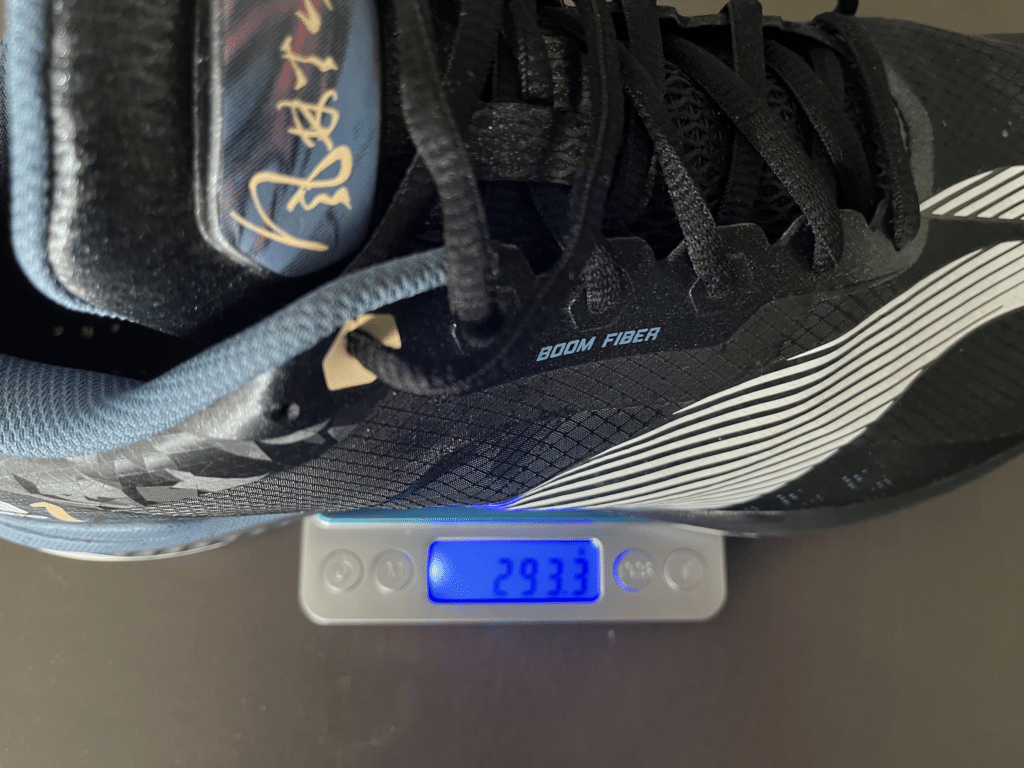
While I was testing this pair on court against the Aerus Z2 head-to-head, I didn’t notice the difference in weight at all.
Before diving into the Li-Ning Mirage Pro review, let me spare you the trouble if you’ve got wide feet. This pair feels narrow and snug from heel to toe, so if your feet are wider than average you’ll likely prefer the Yonex Aerus Z2.
I’m directly comparing the two shoes in the video below (and at the end of this review if you prefer to read).
Table of Contents
Li-Ning Mirage Pro review and my experience
Now, let’s dive into the Li-Ning Mirage Pro review and see how they play!
Unboxing and first impressions
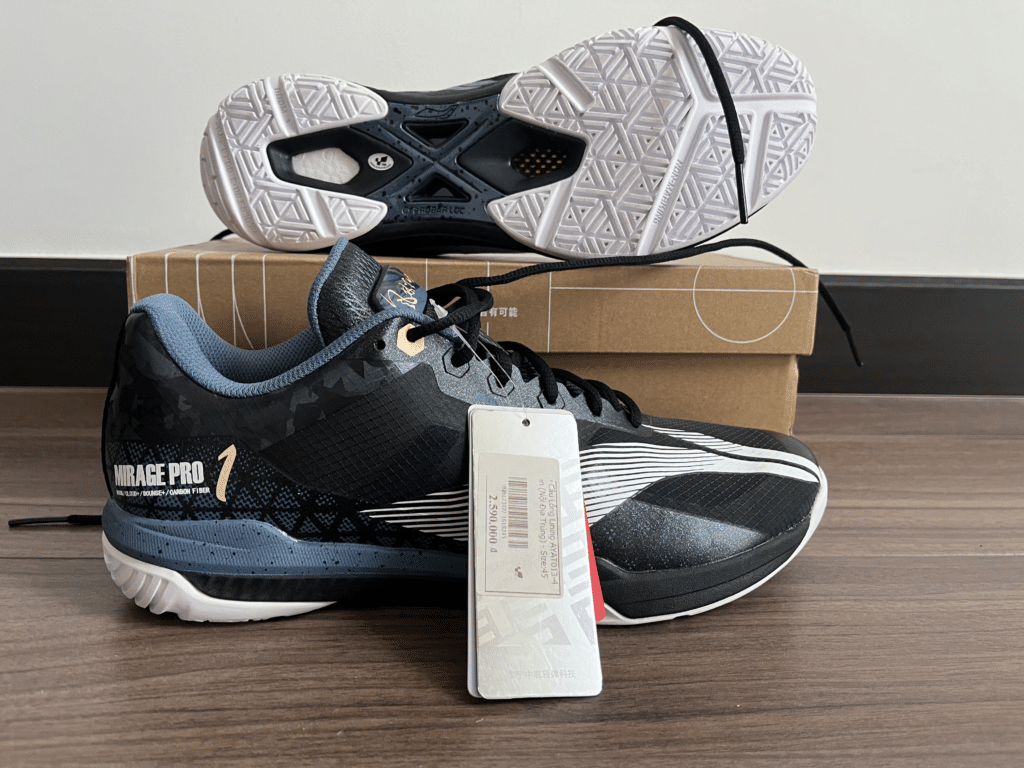
While breaking in this pair at home, I noticed the upper heel area grinding against my skin (despite wearing socks) and it took a little while until things had adjusted. Keep that in mind if you’re trying them on at the store.
The toe area and protection
First, let’s look at the toe box.
As you’d imagine in a shoe fighting like a bride before her wedding to keep the weight off, there isn’t much cushion in the toe box. In fact, while wearing it, it doesn’t feel as if there’s any padding at the very front of the shoe to help you if you’re lunging and bumping your toes against it.
I was concerned because the fatigue I experienced in the Aerus Z2 and Mizuno Wave Claw 3 made for a fairly painful testing experience for my feet. For some reason, that wasn’t as much of an issue for me in the Mirage Pro.
Since the padding is similar to those other shoes, my best guess is that it’s due to the insole offering better slide resistance within the shoe, or the fact that Li-Ning adds a 3-millimeter buffer on their badminton shoe sizing. The latter may offer that tiny bit of extra room that makes the difference.
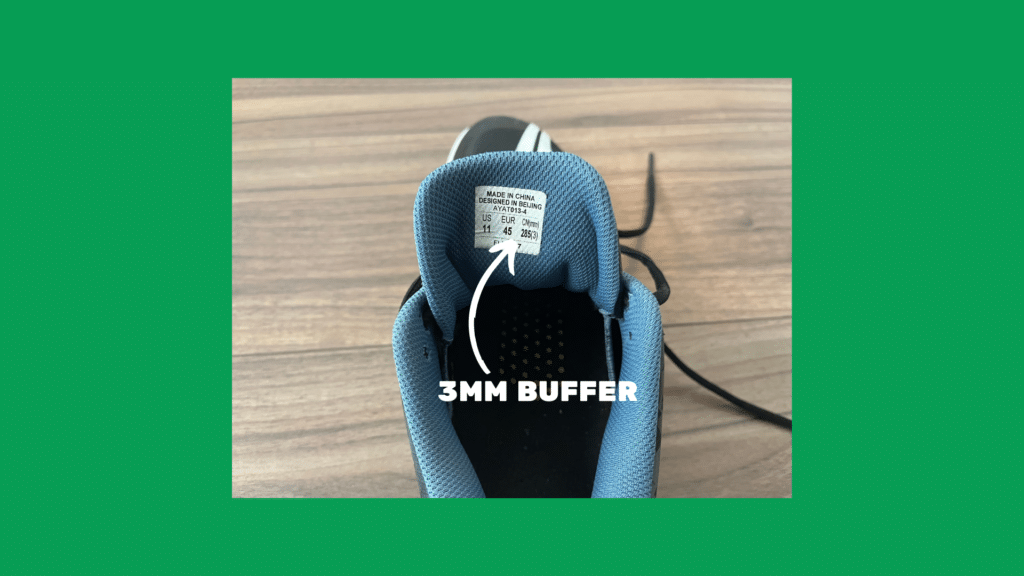
In terms of fit, the toe box feels nicely narrow and offers a terrific fit as my feet are slightly narrower than average. This is great to avoid fatigue on the side of the toes where I often get fatigue from bumping against the side of the shoe in roomier toe boxes.
The heel area
The heel feels snug and narrow too, and slightly stiff. Not stiff as in painful (except mild annoyance when I was breaking it in at home), but rather a reassuring stiffness that made me feel as if my feet were perfectly locked into the shoe and wouldn’t move around. It still has some cushioning in the upper heel area for comfort as well.
If you’re a player with narrow feet or if you prefer a narrow fit around the heel, you’ll like this shoe.
Fit + Upper shoe area
The sides also feel slightly stiff and similar to the heel, it feels as if Li-Ning has put material inside the shoe to stiffen the feel on purpose rather than it being a result of something else they were trying to achieve with the shoe.
The tongue is slightly wider than average. Combined with the narrow sides, I found that it stays in place instead of annoyingly sliding down to the side during every rally, like I’ve experienced with other badminton shoes.
Breathability was no issue in the Mirage Pro, as you’d expect from the low weight.
Cushion and shock absorption
When it comes to midsole cushioning and shock absorption underneath your feet, expect it to be absolutely minimal in order to keep the weight low.
Like the Aerus Z2, it feels like there’s barely any cushion in the midsole, which also means you’ll feel the court more directly (some players love this).
The insole was similar to the one found in competing badminton shoes, but slightly better as it has more ventilation holes. It also has a wavy pattern in the toe area to prevent sliding within the shoe — I found it to do a better job at this than the Aerus Z2, even if it doesn’t go away entirely.

The outsole and grip
The outsole grip is on par with Yonex’s radial blade sole grip, the one used on all their flagship shoes (and my current favorite).
No issues there and a nice upgrade from Li-Ning Yun Ting’s outsole grip.
Durability
Durability is an area where low-weight badminton shoes tend to have a bad reputation and testing a shoe for ten hours on court doesn’t give us players much indication of its longevity.
That’s why I like to look at two clues on the non-racket foot relative to other badminton shoes I test: the lunge tear and the outsole tear.
The lunge tear comes while lunging and grinding the foot against the floor to break the movement. On the Li-Ning Mirage Pro, this looks decent for now but there doesn’t seem to be much protective padding in this area compared to on other badminton shoes, so this could change quickly.

The outsole tear tends to grind the outsole grip away, which I’ve experienced can lead to injuries if you’re expecting grip near the toe box and it’s suddenly not there.
This looked good and without issues.
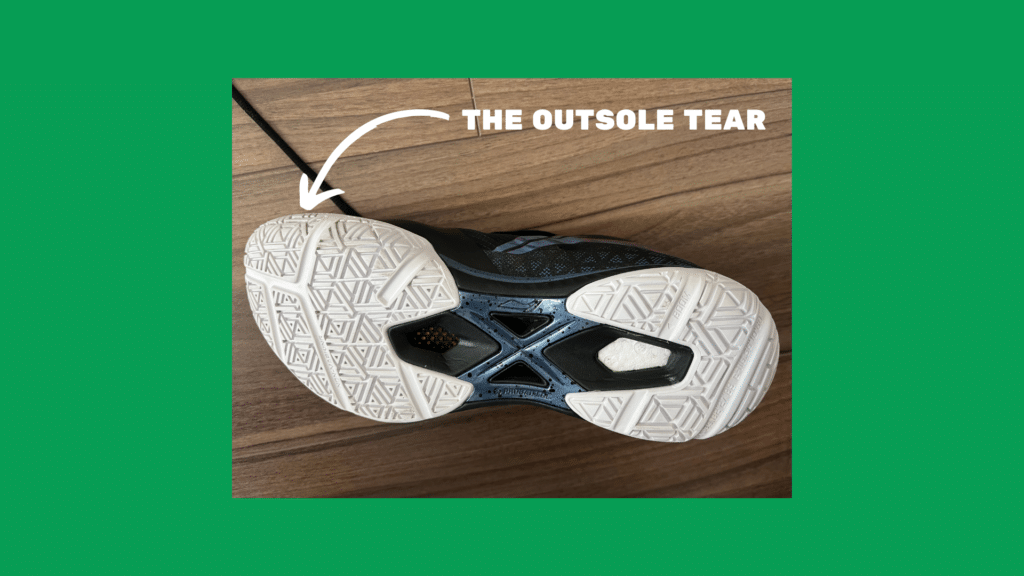
The overall verdict
POSITIVE
I found myself sliding less within this shoe compared to other similar ones.
NEGATIVE
The durability (and lack of padding to prevent it) concerns me.
Li-Ning Mirage Pro: the verdict
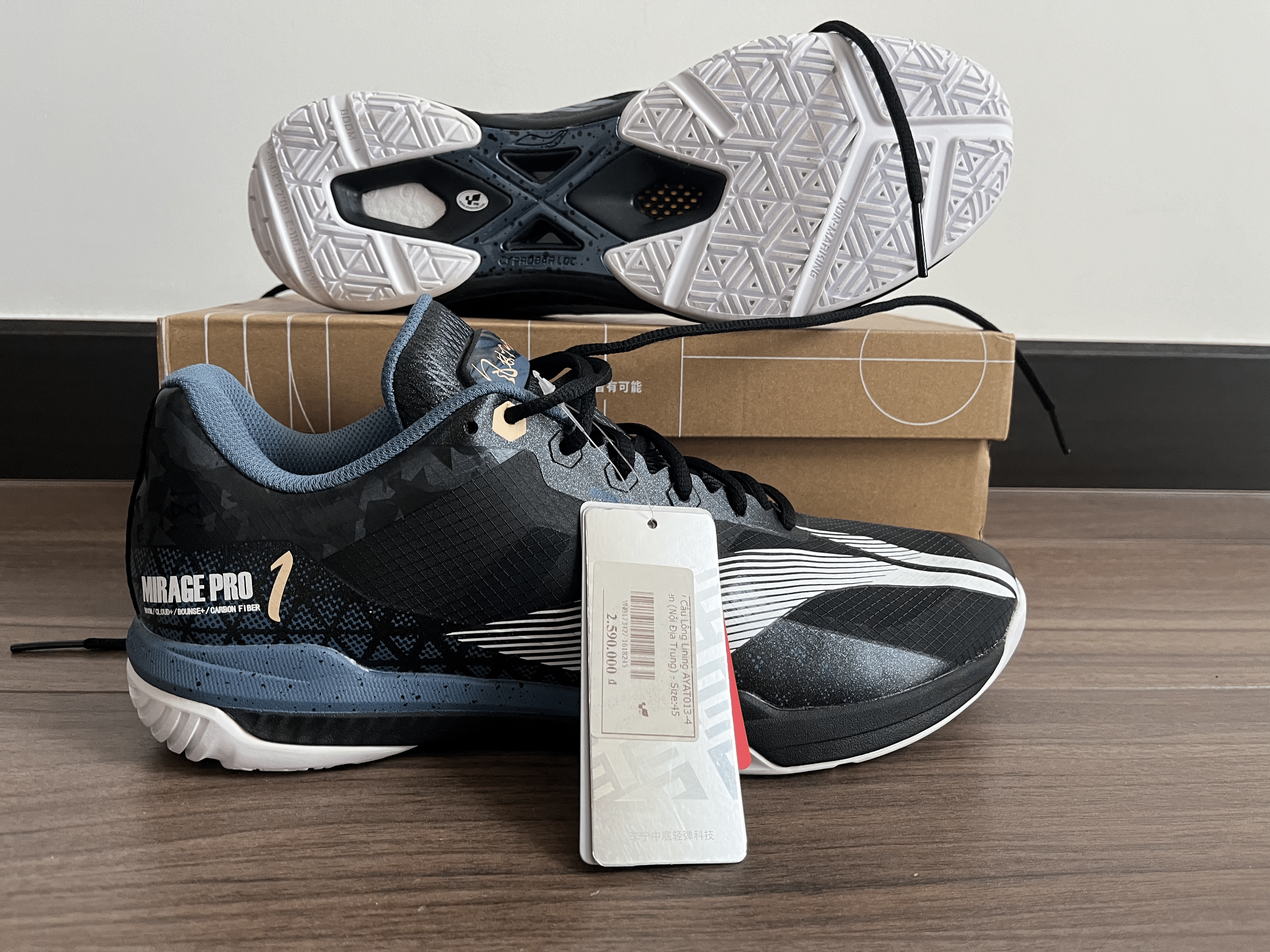
Summary + the beasty score
When cushion and other good stuff are stripped away to reduce the weight, what’s left is the fit and you’ll notice the difference between a well-fitting shoe and one that isn’t, much more.
That makes choosing the right fit for your feet even more crucial. So much so, that you can almost ignore the rest if you don’t get this one thing right. I love the fit in this pair, but since you and I don’t have the same feet, it’s hard to say that it’s “good” since fit is subjective.
I liked the tongue, outsole grip, ankle, and heel support as well, and the toe box’s lack of cushion wasn’t as much of an issue for my poor footwork as I had expected. But I’m concerned about the durability over the long run and I found myself sliding a little within the shoe, which sucks (to be fair, this happened across all shoes I’ve tested in this category).
Ultimately, I won’t be playing in this pair too much as my body is too big for this badminton shoe category. It’s too fatiguing on my legs, knees, and feet beyond small stints — I need more cushioning to avoid injuries.
Which badminton players are best suited for Li-Ning Mirage Pro
Next, let’s get a sense of which type of player this shoe is for.
Who Li-Ning Mirage Pro is suited for
This shoe is well-suited for badminton players with narrow feet.
It’s also suitable for players with a smaller body frame than I, or players my size who prefer speed rather than comfort.
Who Li-Ning Mirage Pro is not suited for
It isn’t suitable for players with average width or wide feet, or players my size or above (unless you don’t mind the fatigue in your legs and feet).
If you’re a beginner player, this shoe might be decent for you. But, I’d go with one that has more toe box cushioning until you’ve improved your footwork and anticipation skills. You’re likely to have bad habits like being late to the shuttle and having heavy landings, and extra cushioning is nice to combat that.
Li-Ning Mirage Pro compared to other similar shoes
As the last step in this Li-Ning Mirage Pro review, let’s compare it with other similar shoes head-to-head.
Li-Ning Mirage Pro vs Yonex Aerus Z2
The Aerus Z2 is Yonex’s direct competitor to the Mirage Pro.
It weighs slightly less (7%) and feels wider in the toe box and sides, something that doesn’t suit my slightly narrow feet. But it could be suitable for you if your feet are average size or slightly wide (I only test the standard edition rather than the wide edition).
The heel feels softer and more cushioned in the Aerus Z2, whereas the Mirage Pro felt stiffer and more snug for my feet without going all in on stiffness.
I noted that the Aerus felt slightly bouncier underneath, which is always fun.
These two pairs are similar when it comes to outsole grip and durability. I’d get the Mirage Pro if you prefer a narrower, more snug fit, and the Aerus Z2 if you prefer something wider.
Li-Ning Mirage Pro vs Mizuno Wave Claw 3
When I had both of these pairs on court at the same time and changed between them, I immediately noticed the extra padding the Mizuno Wave Claw 3 has on the Mirage Pro.
The bit of extra weight (6%) and cushion in the sides, heel, and upper makes it slightly more comfortable to play in for me, but I found myself sliding more within the Wave Claw 3 and that’s a no-go!
It also felt less stiff and with softer, more comfortable, material within the shoe than in the Mirage Pro.
The toe box felt slightly wider than in the Mirage Pro, but slightly narrower than in the Aerus Z2 (somewhere in the middle between the two) and the outsole grip was almost as good as in those two other pairs.
In terms of heel and ankle support, I prefer the Mirage Pro as it’s slightly taller and stiffer which gives a more snug feel for my feet.